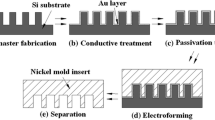Abstract
The uniformity of the porous array seriously affects the performance of the injection-molded parts. In this study, a uniform hole array chip constituted by 384 holes whose radiuses are 1.30 mm is fabricated by precision injection molding technology. To capture the relevance between the uniform dimension of the porous array and the injection molding process parameters, single factor experiment was adopted. Besides, the condensed state of the hole array was studied to give a further explanation of the inner relationship between the hole array and the most sensitive injection process. As for the measurement, the diameter of the hole which next to the gate and away from the gate was investigated by means of universal tool-measuring microscope, and the standard deviation of the hole diameter was chosen to estimate the uniformity of the hole array. Furthermore, the crystal state and interface state were characterized by polarized light microscopy (PLM), used to explain why the difference of those holes appeared. The results reveal that the impact of process parameters on the uniformity of the hole array was ranked as follows: melt temperature, cooling time, mold temperature, injection pressure, injection speed and packing pressure. Besides, the analysis of the condensed state on different melt temperature indicates that the larger grain size is less favorable to the uniform molding, as the melt temperature increases, the difference of cortical thickness between the dynamic template and fixed template sides decreases, product uniformity is improved.







Similar content being viewed by others
References
Cummins C, Gangnaik A (2015) Parallel Arrays of sub-10 nm aligned germanium nanofins from an in situ metal oxide hardmask using directed self-assembly of block copolymers. Chem Mater 27:6091–6096
Song M, Liu Y (2013) Research on incorporate injection molding of the cover sheet and the substrate sheet for microfluidic chip. Mater Sci Technol 21:13–17
Konstantinou D, Shirazi A (2016) Combined hot embossing and milling for medium volume production of thermoplastic microfluidic devices. Sens Actuat B Chem 234:209–221
Metwally K, Barreiere T, Khan-Malek C (2016) Replication of micrometric and sub-micrometric structured surfaces using micro-injection and micro-injection compression molding. Manuf Technol 83:779–789
Packianather M, Griffiths C, Kadir W (2015) Micro injection molding process parameter tuning. Proc CIRP 33:400–405
Hong S-Z (2005) Precision injection molding and factor of mold designing. Die Mould Technol 4:24–33
ManCang S, Hui Z, Shan LJ (2016) Replication of large scale micro pillar array with different diameters by micro injection molding. Microsyst Technol 10:1007–1016
Matschuk M, Larsen NB (2013) Injection molding of high aspect ratio sub-100 nm nanostructures. J Micromech Microeng 23:1–10
Chen X, Leary TF, Maldarelli C (2017) Transport of biomolecules to binding partners displayed on the surface of microbeads arrayed in traps in a microfluidic cell. Biomicrofluidics 11:1–23
Lee F-W, Hung W-H, Ma C-W, Yang Y-J (2016) Polymer-based disposable microneedle array with insertion assisted by vibratingmotion. Biomicrofluidics 10:1–11
Henriksen AD, Rozlosnik N, Hansen MF (2015) Geometrical optimization of microstripe arrays for microbead magnetophoresis. Biomicrofluidics 9:1–14
Xiahui W, Hongwen R, Qionghua W (2016) Polymer network liquid crystal (PNLC) lenticular microlens array with no surface treatment. J Disp Technol 12:773–777
Lihong N, Xiaohong J, Yaolong Z (2016) Large-area, size-tunable Si nanopillar arrays with enhanced antireflective and plasmonic properties. Nanotechnology 31:1–9
Wenggang W, Haiyang M, Xiang H (2016) Fabrication and characterization of SiO2/Si heterogeneous nanopillar arrays. Nanotechnology 30:1–9
Lixia W, Bei W (2003) Research on the influence of process parameters on quality of injection molding products. J Zhengzhou Univ 24:62–66
Group of Mathematical Statistics in Institutes of China (1977) Analysis of standard deviation. Science Press, Beijing, China
Acknowledgements
The authors gratefully acknowledge the support given by the National Key Research and Development Plan of China under Grant No. 2016YFC1202503.
Author information
Authors and Affiliations
Corresponding author
Additional information
Technical Editor: Márcio Bacci da Silva.
Rights and permissions
About this article
Cite this article
Song, Mc., Wang, Xl., Hou, Sj. et al. Investigation of injection molding parameters on the uniformity of porous array of polymer microfluidic chip. J Braz. Soc. Mech. Sci. Eng. 40, 131 (2018). https://doi.org/10.1007/s40430-018-1053-4
Received:
Accepted:
Published:
DOI: https://doi.org/10.1007/s40430-018-1053-4




